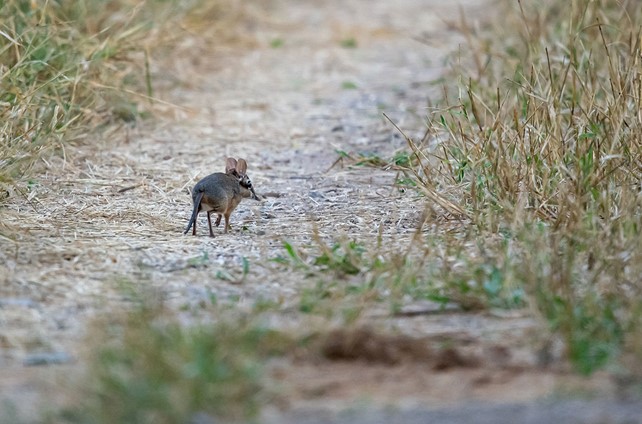April 2022
Four-toed elephant-shrew | sengi
Share:
Four-toed elephant-shrew | sengi
I’ve been longing to photograph one of these cute speedy little animals for ages, and at last (with astronomical ISO and shutter speed) managed to do so early one morning as the little beast was momentarily nosing about a dung pile. They are the “elephant representative” of the Little Five. (The others being the ant lion, rhinoceros beetle, buffalo weaver and leopard tortoise.)
Few mammals have had a more colourful history of misunderstood ancestry than the elephant-shrews, or sengis. Their common name "elephant shrew" comes from a perceived resemblance between their long noses and the trunk of an elephant, and their superficial similarity with shrews. Elephant shrews are not, in fact, shrews. Recent evidence suggests that they are more closely related to a group of African mammals that includes elephants, sea cows, and aardvarks.

Here are a few more fun facts about them:
- This species, as its name suggests, has only four toes on its hind feet.
- Compared to other sengis that have small ears and eyes, a four-toed elephant sengi has broad, upstanding ears and large eyes.
- They have a long, pointed, flexible and sensitive snout, which they use when foraging.
- They have rather long legs for their size, and move in a hopping fashion like rabbits.
- They are extremely fast, and can reach speeds of 28.8 kilometres per hour (17.9 mph).
- Compared to other mammalian insectivores, sengis have relatively large brains.
- They are small insectivorous mammals native to Africa. The four-toed elephant sengis weigh between 160 and 280 g (5.6 and 9.9 oz).
- Their diets include termites, plant matter, centipedes, ants, crickets, millipedes and spiders.
- The young are born in a highly developed state and are weaned by their mothers soon thereafter.
- They have glands that produce a strong scent used to mark territories and deter predators.
- They foot drum or tail slap the ground in stressful situations.

By Jenny Hishin
Author / Field Guide